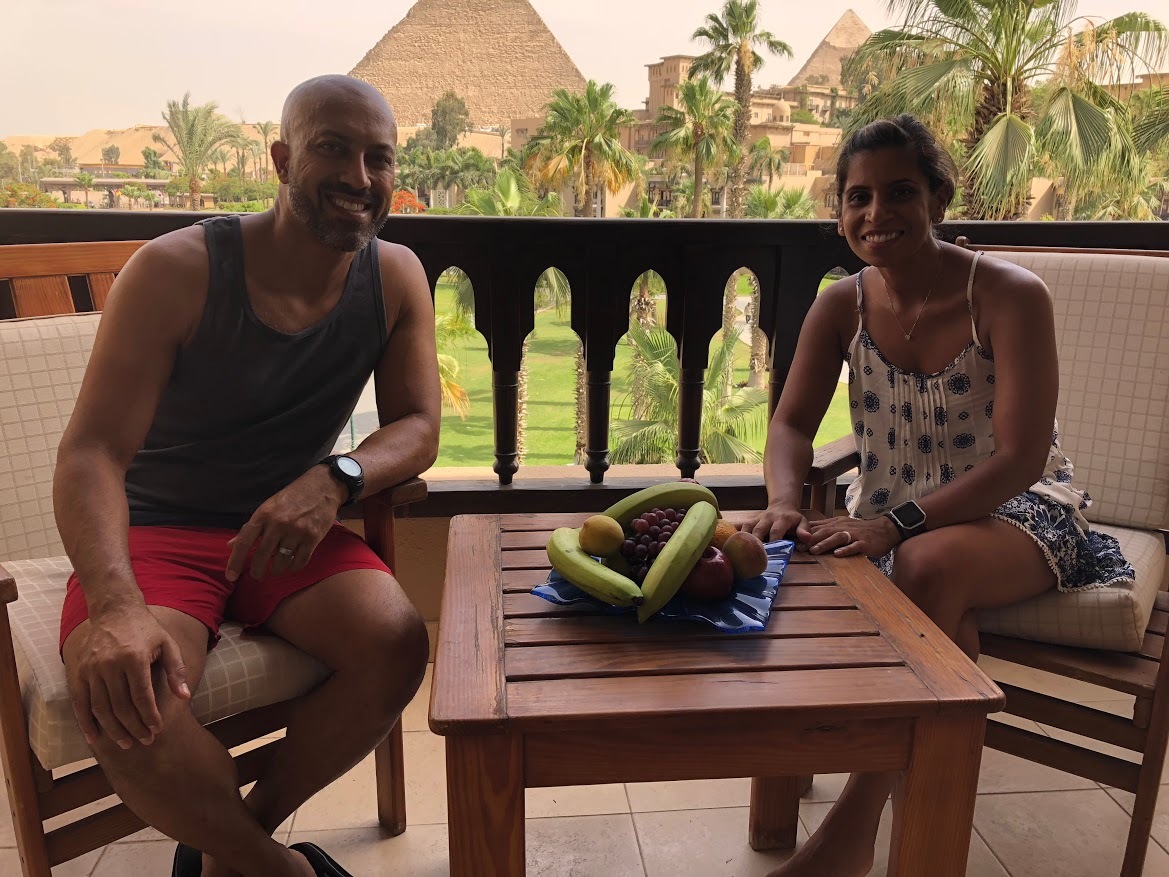AN EXOTIC TRIP FOR OUR TENTH ANNIVERSARY

Niraj and Julie sitting on the patio of their room at the Mena Hotel.
The tenth year wedding anniversary is coming up for Niraj and Julie Kapur on Filly Lane, and they want to plan something big for the family. Niraj had been to Egypt years ago with his father when he was a kid, and he wanted to share this experience with his family. Their kids, Rohan and Sameera, are now six and the idea of an exotic and educational trip began to take shape. Three months before the trip, the family started watching videos of Egypt, and Niraj bought The Encyclopedia of Ancient Egypt. This enormous book shows 500 pages of information and color pictures of everything you might ever want to know about Egypt, like a Ph.D. textbook. He could hardly lift the thing, but the contents are fabulous.
Naraj and Julie started three months before their trip educating the kids on what they were about to see. The hope was that when they were face-to-face with the actual thing, there would be a connection to having seen it in the book and then realizing they knew what it was. “I wanted them to learn about the past and help them appreciate the present,” Niraj said. Both kids learned to say important words like shukran, “thank you,” and salaam, which is a greeting like, “hello” or meaning peace.
When the time came for making concrete plans, they decide to plant themselves in two locations, one in a hotel a few miles north of the Nile River and the other a few miles south of the river. Naraj researched and booked tours for the family.
Their flight took them from Atlanta to Istanbul and on to Cairo, a trip of about 15 hours. The trip was planned for ten days together as a family. Niraj says, “We planned some relaxation time around the pool and other times to fill our intellectual curiosity about this ancient and exotic culture. Reservations for the first few days were at the Mena Hotel, which is right in sight of the pyramids, and the pictures I saw were extraordinarily beautiful ... built in 1883 as an Egyptian Palace and noted as one of the top seven hotels in the world. More affordable than I dared to guess." Julia says, “It was amazing to open up the curtains in the morning and look out on the 3,600-year-old pyramids.”
Deciding to go south to Luxor took the family on a 45-minute flight to see the Temple of Luxor with the Colossus of Rameses II and his courtyard build in 1279-1213 B.C. Later, they traveled north to Karnak to the Temple of Amun and over across the Nile to the Temple of Hatshepsut (1473 -1458 B.C.), who was the queen of Egypt for 20 years. The last adventure of the day was to the Valley of the Kings. where 26 pharaoh kings, including King Tut, were buried.
Cooling down the pace after such a full packed day, they took the next day to visit the malls and restaurants to try the local food and experience the customs. Family time at the pool was relaxing and welcome, as the temperature climbed above 110 degrees.
Changing from the slower pace, they chose to go to the old city of Giza to visit the famous pyramids mostly built between 2589 and 2504 B.C. “The Great Pyramid” was the first and largest built by Pharaoh Khufu in 2551 B.C. Here, they also found the Great Sphinx of Giza, which has the body of a lion and the face of the pharaoh to symbolize strength. It stands guard of the spirits of the pharaohs. Then, time for a little fun, as the family decided to take a camel ride. I asked Rohan what he thought about all that, and he replied, “It was bumpy but very exciting. I held on real tight to the saddle horn, so I didn’t fall off.” Now, they know the word emshee, which means “go” for a camel. I hope they know the word for "stop," too.
Continuing their intellectual pursuits brought a half-day visit to the Cairo Museum, with some 43,000 artifacts including the treasures of King Tut. Niraj marvels that, “Some of the things that impressed us the most were in King Tut’s sarcophagus, which contains three coffins nested within each other and has been preserved for over 3,000 years. His coffin was solid gold, and the death face mask is made from 22.5-carat gold. The eyebrows and eye surrounds are lapis lazuli (deep royal blue) with quartz for the eyes, obsidian for the pupils, and other stones like turquoise and faience are also present. It’s breathtakingly beautiful."
The other important visit was to Saqqara and Memphis, which was the Egyptian capital. Saqqara contains the Step Pyramids, which was the first pyramid built in 2670 B.C. Julia tells me, “This was a great trip; we felt totally safe and were humbled by this cultural experience. To see how other societies live and to share that with the kids was an incredible learning opportunity for our family.”